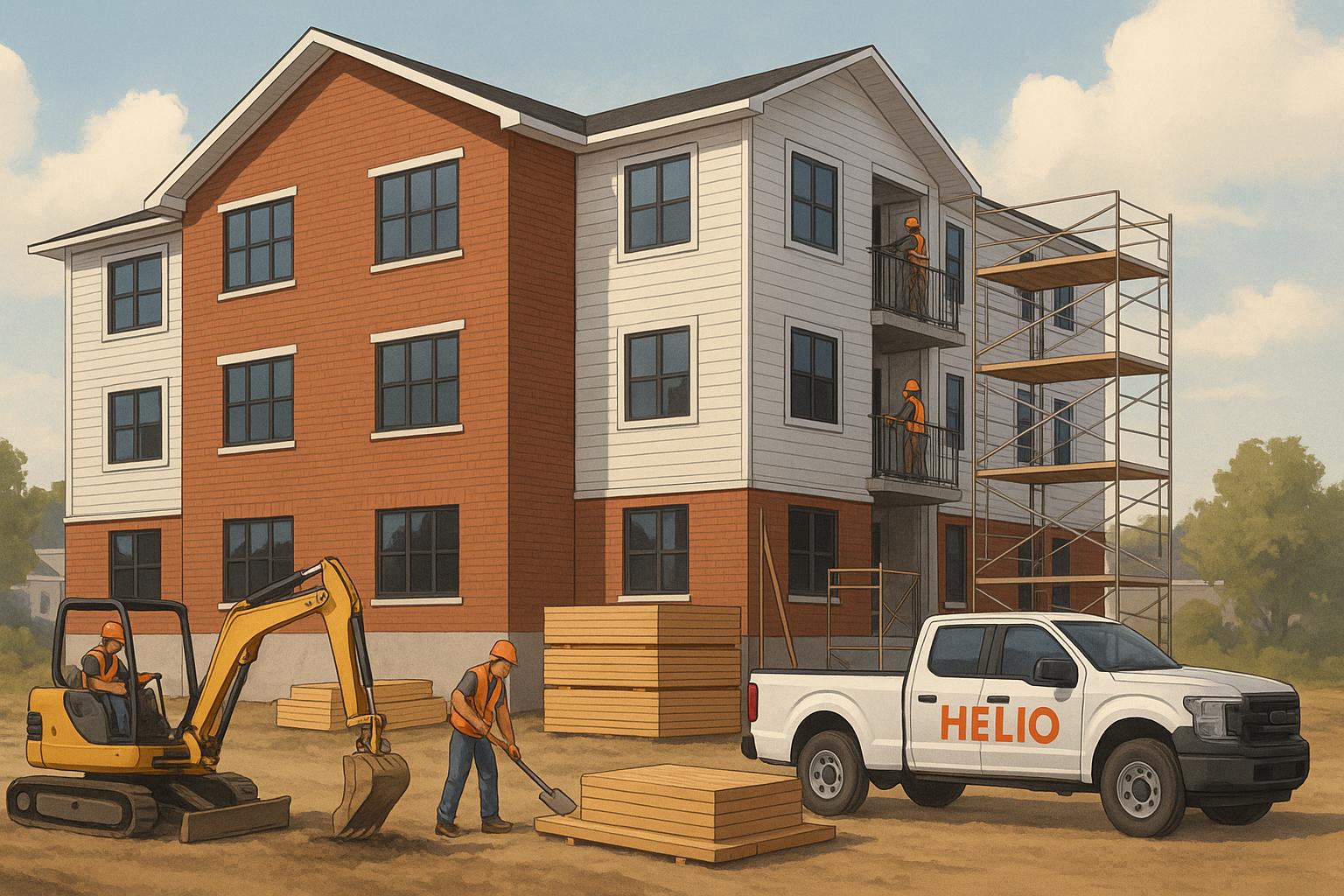In Nova Scotia, building permits are mandatory for most construction projects. Whether you're building a new home, renovating, or developing multi-unit properties, permits ensure compliance with safety codes and zoning laws. Here's what you need to know:
- You Need Permits For: New construction, structural changes, system upgrades (electrical, plumbing, HVAC), fire safety installations, occupancy changes, and major renovations.
- You Don’t Need Permits For: Cosmetic interior work (painting, cabinets), small sheds under 10 sq. m, routine maintenance (roof repairs, siding), and minor electrical or plumbing repairs.
- Process Overview: Start with a Development Permit (zoning and land use), then apply for a Building Permit (safety and technical compliance). Processing times can range from 1-3 weeks depending on the permit type.
- Skipping Permits Risks: Double fees, project delays, denied occupancy, and legal issues.
Always check with your local municipal office to confirm specific requirements and avoid costly mistakes. This guide breaks down the steps, documents, and timelines to help you navigate Nova Scotia's permit process efficiently.
(The Lack of) Building Permits in Halifax, Nova Scotia: Canada's Open Secret.
When You Need a Building Permit in Nova Scotia
In Nova Scotia, building permit requirements align with the National Building Code of Canada. Essentially, any construction, alteration, or addition that impacts a structure's safety, stability, or use will likely need a permit.
For multi-unit developments, the rules are even stricter to meet higher standards for fire safety, accessibility, and density. Here's a quick guide to help you understand which projects need permits and which typically don’t.
Projects That Always Need Permits
- New Construction: Whether it’s a single-family home, duplex, fourplex, or larger multi-unit building, a permit is mandatory. Even smaller accessory structures, like garages or workshops, require permits if they exceed the local size limit (usually about 10 square metres).
- Structural Changes: Any work that affects a building's stability - like removing load-bearing walls, adding extra levels, or expanding the footprint - requires a permit. Foundation work, such as basement excavations or structural repairs, also falls under this category.
- System Installations and Modifications: Major changes to electrical, plumbing, or HVAC systems usually require permits to ensure they meet safety codes. In multi-unit projects, these systems face additional checks to meet stricter standards.
- Fire Safety Upgrades: Installing or upgrading fire alarms, sprinklers, or emergency lighting almost always requires a permit, especially in buildings with multiple occupants.
- Occupancy Changes: Converting a single-family home into a multi-unit property or changing the use of a space typically requires a permit. Sometimes, both development and building permits are needed.
- Major Renovations: Significant changes to a building’s structure or systems, or projects that alter its internal layout or intended use, must be reviewed and approved by local authorities.
Projects That Don’t Need Permits
- Cosmetic Interior Work: Renovations like painting, replacing cabinets, or other updates that don’t involve structural changes or major systems don’t require a permit.
- Small Accessory Structures: Garden sheds or storage buildings under 10 square metres usually don’t need permits, though they must still follow setback and height rules.
- Routine Maintenance: Repairs like fixing a roof, replacing siding, or swapping out fixtures are typically permit-free - as long as they don’t involve major changes to systems or structures.
- Minor Electrical and Plumbing Work: Replacing light fixtures, outlets, faucets, or repairing leaks doesn’t require a permit. However, installing new circuits, upgrading electrical panels, or adding plumbing lines does.
- Temporary Construction Structures: Items like scaffolding or temporary fences generally don’t need building permits but might require other municipal approvals depending on their location and duration.
Knowing these guidelines can help developers, especially those working on multi-unit projects, stay compliant with Nova Scotia’s regulations and avoid unnecessary delays. If you’re unsure whether your project needs a permit, it’s always best to check with your local municipal building department. This ensures compliance and prevents issues like stop-work orders or hefty fines.
How to Apply for a Building Permit
Now that you’re familiar with the permit guidelines, let’s walk through the application process. Securing a building permit requires thorough preparation and coordination with your local municipal office. While each municipality in Nova Scotia may have its own specifics, understanding the common steps and requirements can help you move through the process more efficiently. Start by gathering the necessary documents outlined below.
Required Documents
To ensure your application is complete, you’ll need to provide several key documents. These help municipal offices determine if your project aligns with building codes and zoning regulations.
- Site plans: These are the backbone of your application. They must detail your property boundaries, existing structures, and the location of your proposed construction. Include setbacks from property lines, utility connections, and, for multi-unit projects, additional details like parking, waste management, and landscaping. Make sure the plans are to scale and measurements are precise - municipal reviewers will compare these against zoning bylaws.
- Architectural drawings: These provide a detailed look at your project and include floor plans, elevations, and cross-sections. They should show layouts, openings, ceiling heights, and accessibility features. If you’re working on a multi-unit development, you’ll also need to include details such as fire separation walls, emergency exits, and common area layouts. Your drawings must demonstrate compliance with the National Building Code, particularly for safety systems and occupancy limits.
- Structural specifications: These must be prepared and stamped by a licensed professional engineer in Nova Scotia. Include foundation designs, load-bearing elements, and structural connections. For multi-unit buildings, you’ll also need to address seismic requirements and wind load calculations specific to your area.
- Mechanical and electrical plans: These technical documents should cover HVAC systems (heating, cooling, and ventilation), energy efficiency measures, and electrical layouts. Include details like service entrances, panel schedules, outlet placements, lighting layouts, and fire alarm systems. Plumbing plans should show water supply lines, drainage systems, and fixture locations.
- Supporting documentation: Depending on your project and location, additional documents may be required. These could include a surveyor's certificate, environmental assessments, traffic studies, or heritage impact assessments. For larger projects, such as multi-unit developments, you may also need stormwater management plans or geotechnical reports.
Once your documents are ready, you’ll need to engage with your local municipal office to move forward.
Working with Municipal Offices
Navigating municipal building departments can feel overwhelming, but understanding how they operate can save you time and reduce stress. Here are some strategies to help you work effectively with these offices.
- Pre-application meetings: Many municipalities offer pre-application meetings, which are especially helpful for larger or more complex projects. These meetings allow you to share preliminary drawings and ask questions about zoning, required studies, and submission timelines. They’re a great way to identify potential issues early and build rapport with municipal staff.
- Application submission: When submitting your application, ensure all documents are complete and accurate. Missing paperwork or incomplete drawings can result in automatic rejections, delaying your timeline. Double-check that all drawings are properly scaled, signed, and dated. Don’t forget the application fees, which vary depending on the municipality and the type of project. For instance, Halifax Regional Municipality calculates fees based on the construction value and building type.
- Review processes: Your application will likely go through several departments for review. Building officials will assess code compliance, planning staff will verify zoning, and engineering teams will evaluate infrastructure impacts. For multi-unit developments, the fire department may also review life safety systems and emergency access. Understanding these parallel reviews can help you address comments more effectively.
- Responding to review comments: Once municipal reviewers provide feedback, respond quickly and thoroughly. Some comments may require revisions to your drawings, while others might call for additional documentation or clarification. Addressing these promptly keeps your application moving forward.
- Permit conditions: Approved permits often come with conditions, especially for larger projects. These might include specific inspection schedules, bonding requirements, or construction management plans. Knowing these conditions upfront helps you plan your budget and avoid compliance issues later.
Clear communication and professionalism are key when working with municipal offices. Building department staff want to see projects succeed while ensuring they meet regulations. By submitting complete documents, maintaining professional interactions, and being responsive to feedback, you can develop positive relationships that will benefit this and future projects.
Though the process requires patience and attention to detail, thorough preparation and good communication can make the journey much smoother. Taking the time to understand the requirements and build connections with municipal staff can save you time and headaches down the line.
sbb-itb-16b8a48
How Permit Rules Differ Between Municipalities
Permit requirements and processes can vary widely depending on the municipality. For multi-unit developments, these differences can significantly influence timelines and costs. Knowing how each municipality operates is critical when planning your approach to permits.
Main Differences Between Municipalities
Each municipality has its own way of handling permits, which can impact how quickly and smoothly your project progresses.
Halifax Regional Municipality (HRM) has a detailed permit system in place. It requires both development and building permits, along with extensive documentation like stormwater management plans and traffic impact assessments.
East Hants Municipality offers a more streamlined approach. Preliminary permits can be obtained for building, septic, and water systems, allowing site preparation to begin early.
West Hants Municipality follows a moderately complex process. While similar to smaller municipalities in some respects, it sometimes imposes stricter setback rules, which can influence building design and site layout.
Colchester County generally has fewer permit requirements but takes a more thorough approach for larger multi-unit projects. In some cases, additional fire department reviews can extend approval times for certain project types.
Kings County has extra review steps and enforces stricter architectural guidelines, especially in heritage or agricultural areas. These requirements can add to the project timeline.
Inspection schedules also differ between municipalities. Some require multiple inspections at various stages - like after foundation work, framing, and before completion - while others combine phases or offer more flexible inspection options.
Development Permits vs Building Permits
Understanding the distinction between development and building permits is another important step in navigating the process.
Development permits focus on zoning and land-use regulations. They cover aspects like structure types, setbacks, parking, and landscaping to ensure compliance with local by-laws.
Building permits address the technical and safety aspects of construction. These permits ensure that your project meets local building codes, covering areas like structural integrity, fire safety, and accessibility. Applications for building permits usually require detailed architectural drawings and engineering plans.
Some municipalities allow development and building permits to be reviewed at the same time, which can speed up the process. Others require a step-by-step approach, which can take longer. Fee structures also vary - some municipalities charge separate fees for each permit, while others bundle them into a single cost.
To avoid delays, it’s essential to identify the permits your project needs early on. Multi-unit developments typically require both types, and the order and requirements can differ depending on the municipality. Consulting your local building department during the design phase is a smart move to clarify timelines, fees, and specific requirements.
What Happens When You Skip Permits
Skipping permits might seem like an easy way to save time and money, but it can seriously affect your project’s timeline, budget, and even the legality of renting out your property.
Penalties for Building Without Permits
In Nova Scotia, bypassing permits comes with strict consequences:
- Starting construction without an approved building permit means you could face double the standard permit fees [2].
- If your work hasn’t been inspected due to missing permits, you might be denied essential services, utility hookups, or even occupancy permits [2].
- Unpermitted construction can lead to unresolved issues like building code violations, bylaw infractions, or fire code problems. These could show up in a Municipal Clearance Letter, potentially blocking your ability to rent the property legally [2].
How to Stay Compliant
Avoiding these penalties is straightforward if you take the right steps:
- Plan ahead. Before starting construction, check with your municipal office to understand which permits your project needs. For multi-unit developments, remember that both development and building permits are usually required - factor this into your timeline early.
- Work with experienced contractors who are familiar with local building codes. They can help ensure compliance and save you from costly mistakes or delays [2].
- Schedule all necessary inspections as your project progresses. Keep detailed records of permits, inspection reports, and any correspondence to show you’re following regulations [2].
- Include permit fees, inspection costs, and potential design adjustments in your initial budget to avoid surprises later.
- Verify zoning rules early to make sure your rental plans align with local requirements. Renting is allowed as long as the property complies with zoning laws and all required permits are in place [2].
Conclusion: Follow Permit Rules to Avoid Problems
Navigating Nova Scotia's permit rules is essential to protect your investment and keep your multi-unit rental project on track. In the province, building permits are a legal requirement for any construction work, and areas governed by a Land Use By-law also demand a development permit[1].
To avoid setbacks, factor permit processing times into your project timeline. A little planning ahead can save you from unnecessary delays[1].
Partnering with your local planning office can make the process smoother. They can guide you through local regulations, help ensure your plans align with the National Building Code, and assist in securing approvals from municipal engineering, transportation, fire safety, and other relevant departments[1].
FAQs
What happens if I don’t get the required permits for my home renovation in Nova Scotia?
Not getting the right permits for your home renovation in Nova Scotia can lead to serious problems. Municipalities have the authority to issue stop-work orders, demand that unapproved work be reversed, or even impose hefty fines - up to $250,000 for corporations. These penalties can result in expensive delays and throw off your entire project schedule.
On top of that, skipping permits can cause headaches when it’s time to sell your home. Any renovations done without proper approval must be disclosed to buyers, which could lower your property’s value or scare off potential buyers. Following permit rules not only protects your investment but also makes future transactions much simpler.
What steps should I take to ensure my building plans meet Nova Scotia and National Building Code requirements?
To make sure your building plans align with the National Building Code of Canada (NBCC) and Nova Scotia's municipal guidelines, begin by consulting the Nova Scotia Building Code Regulations. These regulations integrate the NBCC and address critical areas like fire safety, accessibility, energy efficiency, and structural stability.
After that, reach out to your local municipality - such as Halifax - since they enforce these codes through specific bylaws. Double-check that your plans comply with any additional local requirements and secure all the necessary permits and approvals. Following these steps can save you from unexpected delays, fines, or expensive revisions as your project progresses.
How can I simplify the permit process for my construction project in Nova Scotia and avoid delays?
To streamline the permit process in Nova Scotia and steer clear of unnecessary delays, begin by collecting all the necessary documents before submitting your application. This includes detailed site plans and project specifications, ensuring they align with local building code requirements. Proper preparation can help you avoid rejections or the need for revisions.
When it comes to inspections, schedule them well in advance - ideally 48 to 72 hours ahead. This approach keeps your project running smoothly and on time. Staying in regular contact with municipal authorities is also key. It allows you to stay informed about any regulatory updates and address potential issues early. A proactive and organized approach can save both time and money, helping you sidestep expensive setbacks.



